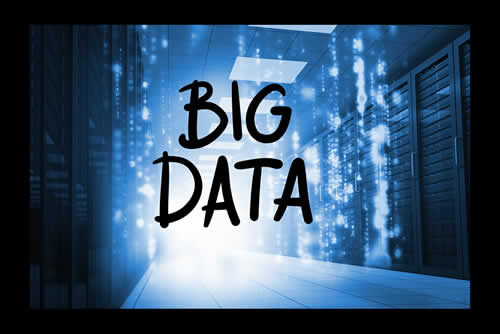Imagine buying a gift for someone you’ve never met in your entire life. What would be your bottlenecks? You don’t know the first thing about them, and without any information to go on, every suggestion you make is, frankly, a stab in the dark.
On the other hand, when you know someone, you can remember previous interactions you had with them and know something about how they communicate. For instance, you could remember a time they discovered a new show and wouldn’t stop talking about it for three weeks. Because of this, you could decide to get them a lamp that the main character has on their nightstand, or maybe a t-shirt with a character from the show.

Now, imagine if you knew everything about them - every interaction they had with anyone ever, and had a way to analyze it and produce results/insights on demand. Just how easy would it be to pick a perfect present? This is how big data works.
By having an enormous amount of data that you can couple with business intelligence (BI) and AI analytical tools, you have a much easier way of analyzing your audience and pinpointing the exact approach and design that will allow you to appeal to your audience. It’s like telling someone the right thing at the right moment in order to persuade them to respond.
Sounds too good to be true? Well,
here’s how it works and why it matters!
What Is Big Data In Marketing?
So,
what is big data in marketing? Well, we’re all collecting a whole lot more data than ever before, and although this leads to overload, the tools for making sense of it are finally catching up. Businesses can no longer afford to rely on gut instinct alone. Now they have access to years’ worth of customer interactions and behavior, and can decide what actually works. But of course, it’s not just about having a lot of data. It’s about being able to sift through the chaos and spot something useful in it. And that’s the power of big data.
Text messages, voice notes, random social media comments - this stuff used to be messy and unusable. But now?
Now we’ve got software that can make sense of it without needing to translate it into neat spreadsheets first. That means you can take raw, chaotic feedback and turn it into something that guides your next marketing move. And it saves a ton of time, too.
It’s like being handed puzzle pieces of a person’s preferences, one by one. Favorite brands, spending habits, search history - each of these tells you something valuable. Moreover, when you stitch them together the right way, you start to see the bigger picture of what this person wants, even before they say it out loud.
It used to be a win if you remembered someone’s birthday or favorite color. Now you can track how long they lingered on a product page or whether they abandoned a cart. Also, the bar has been raised -
people expect you to know them better, even if they’ve only interacted with your brand once.
Here’s the thing - big data doesn’t just help you create the perfect message for one person. It helps you decide
what kind of message works best across entire demographics. So of course it’s great for a single ad or campaign, but it’s also your secret weapon for shaping your long-term strategy. In other words, you can use it to play both the short and long game.

Where Does Data Marketing Come From?
Social media isn’t just a place for memes and hot takes - it’s a goldmine of useful signals. Every like, share, or comment by someone tells you something abou them. You see what content they enjoy, what time of day they’re most active, and which posts make them stop scrolling … and engage. And their accumulated behavior paints a clear picture of them.
Your website is
constantly gathering useful information. Clicks, scrolls, time spent on each page are valuable signs of interest, curiosity … or even confusion. And when you look at heatmaps or page analytics, you start to understand what’s working and what isn’t. It’s like listening without anyone actually saying a word.
Someone’s purchase history is your record of what made them say “yes” in the past. You see patterns in what they buy, how often, and whether they return for more. Moreover, that tells you what they like and what might convince them again. Repeat behavior often hints at what to recommend next.
Emails are another underrated goldmine. Open rates tell you what subject lines work, while click-throughs tell you which offers hit the mark. If someone opens everything but never clicks, that’s an entirely different signal. You’re not just guessing here - you’re watching how people behave and adjusting your approach based on that.
Surveys and feedback forms aren’t always fun, but when someone takes the time to respond, that’s marketing treasure. You’re getting insights directly from the source - what they liked, what bugged them, what would make them come back. Direct input confirms or challenges what the data is already hinting at.
How Marketers Process This Data
AI tools take all that chaotic information and start spotting patterns faster than any human could. You’re not just crunching numbers -
you’re teaching machines to notice behaviors that lead to a sale ... or maybe a bounce. These tools can keep doing it while you sleep, constantly improving as more data rolls in.

Once the data’s in, the next step is grouping people by traits they share, maybe one group loves discounts and another responds better to premium packaging. You’re essentially creating mini-audiences within your larger audience. This lets you send messages that actually resonate instead of tossing one generic pitch to everyone.
Not every lead is the same. Some people are just looking around, while others are a click or two away from buying.
That’s where lead scoring comes in. By assigning points based on behavior - clicks, visits, downloads - you get a better sense of who’s worth reaching out to and who’s not quite ready.
When you line up someone’s behavior with your previous campaigns, you start seeing what types of content or ads worked best. Maybe certain videos got high engagement from younger audiences, or specific CTAs worked better on mobile. You use past success to guide future moves, keeping things grounded in results.
Automation ties it all together. With enough data, you can send a personalized email the second someone clicks a certain product. You can recommend products mid-scroll or follow up after cart abandonment. It’s not about being everywhere - it’s about being in the right place at the right time, automatically.
What Big Data Reveals About Your Audience
When you’ve got enough data,
people’s preferences become much clearer. You can spot which products they hover over, which categories they explore, and which ones they ignore. You’re not reading their minds, but you are paying attention to their choices, and that tells you exactly what to show them next.
It’s not just about what people buy - it’s also about when they buy. Maybe someone shops every Friday evening or tends to buy gifts around certain holidays. This timing data lets you meet them exactly when they will most likely say yes. That’s way more effective than random outreach.
 Different people trust different platforms
Different people trust different platforms. Some prefer emails, others respond best on Instagram. Big data reveals where your message is most likely to land. Moreover, this helps you avoid wasting time yelling into the void on channels your audience doesn’t care about. You go where they’re already paying attention.
You can also see how people reacted to your previous campaigns. Did they open the email but not click? Did they unsubscribe after one promo too many? These aren’t just vanity metrics - they’re honest feedback. They show you what landed and what missed the mark so you can fix it.
Loyalty doesn’t come out of nowhere. Big data shows you what actions led to repeat purchases or higher spending. Maybe it’s a great customer service moment or a discount that came at the right time. You can start building those moments on purpose when you understand the steps that build loyalty.
How Big Data Shapes Personalized Marketing
Personalized emails go way beyond inserting a first name! With the right data, you know which products to feature, what tone to use, and even the best time to hit send. These aren’t just emails - they’re mini conversations that make the customer feel that you actually “get” them.
Ads don’t have to be generic anymore, either. You can tailor them based on browsing history, cart activity, and past actions. And what this does is to make the ad feel
more like a suggestion from a friend than a (clumsy) cold pitch. And that small shift in tone can make all the difference between scrolling past or clicking.

Even your landing pages can adjust based on who’s visiting. Maybe one version highlights free shipping for budget shoppers, while another focuses on premium features for high spenders. You’re essentially saying, “Hey, I know what matters to you,” and that makes people more likely to stick around and explore.
You’re not always
guessing what someone might like. Sometimes, the data already tells you if a customer just bought running shoes, there’s a good chance they’ll be interested in performance socks or fitness gear. Predicting the next step isn’t magic - it’s just reading the signs they’re already leaving behind.
You can also adjust your offers based on a person’s previous behavior.
The Engine Behind Smart, Efficient And Personal Outreach
You’re no longer left hoping a campaign works;
you’ve got real answers from real behavior. And it gives you the power to act faster, spend smarter, and connect better. It works whether you’re trying to land one customer or a thousand. Sure, it takes the right tools and a bit of learning, but if you do it right, the payoff will take your breath away!




























